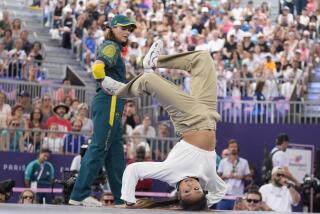Doping Scandal Dogs U.S.
- Share via
ATHENS — With the Summer Games set to begin Friday, the entire 531-member U.S. team arrives here under a cloud of suspicion, shadowed by the most significant doping scandal in U.S. Olympic history, according to experts, officials and athletes.
Since Jan. 1, more than 20 track and field athletes have been sanctioned, implicated or identified as the focus of an inquiry in a scandal sparked in large part by the investigation of BALCO, a nutritional supplements company in Burlingame, Calif. Prosecutors allege that BALCO’s founder, Victor Conte, and three others distributed steroids to athletes. All four have pleaded not guilty to federal charges.
With the Games drawing near, some experts say, the integrity and credibility of the entire U.S. Olympic program are at issue.
“U.S. track and field is just out of control,” said Dick Pound, a longtime member of the International Olympic Committee and president of the Montreal-based World Anti-Doping Agency. “There’s a kind of sleaze factor that is unfortunately affecting all the athletes, and that’s not fair. But it’s affecting all of them.”
For the U.S. Olympic effort, “this is our Ben Johnson moment,” said Gary Wadler, a Long Island physician and anti-doping expert, referring to the outcry in Canada when Johnson was stripped of his gold medal in the 100-meter dash in 1988 at the Seoul Games upon the disclosure of a positive steroid test.
U.S. swimmer Lindsay Benko, a Sydney gold medalist who will swim the 200-meter freestyle in Athens, said: “It’s an extremely unfortunate situation, not just for track and field but for all Olympic sports. I think it does overshadow what the Olympics are supposed to be about and it’s kind of what the Olympics has come to.”
The doping scandal involving U.S. track and field athletes has, at times, seemed relentless this year:
Twelve athletes have been sanctioned for doping offenses, including four for using THG, the designer steroid at the center of the BALCO matter. The 12 account for half of the 23 sanctions announced this year by the U.S. Anti-Doping Agency.
Four sprinters face a lifetime ban from competition, including Tim Montgomery, the world-record holder in the 100-meter dash.
Marion Jones, winner of five medals at Sydney, three of them gold, and possibly the nation’s most famous track star, remains under scrutiny. Jones, expected to compete here in the long jump, has consistently denied the use of performance-enhancing substances. She and Montgomery are companions and the parents of a 1-year-old boy.
Jones’ ex-husband, former shotput champion C.J. Hunter, told federal investigators that she had used banned substances before, during and after the Sydney Games, according to a report recently published in the San Francisco Chronicle. Her lawyers say Hunter is lying.
Sprinter Torri Edwards, a medal hope in the 100- and 200-meter sprints, last month acknowledged that she inadvertently used the banned stimulant nikethamide. On Thursday, track’s worldwide governing body, the International Assn. of Athletics Federations, imposed a two-year ban that would keep her out of the Olympics, barring an appeal.
On Monday, the U.S. Anti-Doping Agency announced that sprinter Calvin Harrison was out for two years because of a positive test last year for the stimulant modafinil. Barring a successful appeal, he is ineligible for the 2004 Games.
Moreover, the International Olympic Committee, in a rare action, is weighing whether to strip the U.S. men’s 1,600-meter relay team of its gold medals from Sydney because Jerome Young, who ran in the preliminary rounds of the relay, tested positive the year before for a banned steroid. Harrison ran in that relay, as did his twin brother, Alvin; Alvin Harrison is among those facing a life ban.
“It’s a dark moment in U.S. Olympic history,” said Steven Ungerleider, an Oregon researcher and author of “Faust’s Gold,” a study of the East German doping machine of the 1970s and 1980s. Referring to those U.S. team members who are playing by the rules, he added, “Their moment of glory is being overshadowed by these dark clouds.”
The run-up to Athens hardly marks the first time doping revelations have marred Olympic sports.
In the 1990s, 32 Chinese swimmers were caught for drug offenses, according to “Swimming’s Hall of Shame,” a history of doping offenses compiled by Brent Rushall, a sports scientist at San Diego State University.
At Sydney, three Bulgarian weightlifters were disqualified after testing positive. In Australia, Olympic and anti-doping officials are sorting out a scandal involving cyclists and possible human use of a growth hormone designed for horses.
And, a generation ago, East German swimmers dominated the Olympics, but only after the fall of the Berlin Wall did it emerge that the East German government had doped its athletes.
Ungerleider stresses that the BALCO scandal does not compare to what happened in East Germany. The U.S. government is not systematically doping young people, he said.
For years, however, it was believed that U.S. sports officials were arbitrary, inconsistent, even lax in enforcing doping rules -- particularly in track and field. The U.S. is the undisputed leader among the world’s 202 national Olympic committees, and track traditionally is the glamour sport of the Summer Games.
“Worldwide, there’s always been a suspicion that Americans have money, and money means the ability to get drugs,” said Bill Roe, president of USA Track & Field. “That’s been a perception for a long time ... the perception that we cover things up.”
He and other USATF officials say that perception is wrong.
“We don’t want cheaters in our sport,” Craig Masback, USATF’s chief executive, has said repeatedly.
It was only with the creation four years ago of the U.S. Anti-Doping Agency, however, that perceptions abroad began to change -- at the cost, perhaps, of a scandal that illuminated a new, harder-line approach.
USADA, based in Colorado Springs, Colo., assumed doping oversight from various U.S. sports federations and the U.S. Olympic Committee. USADA officials have shown that they will rely on any evidence, direct or circumstantial, to try to tie an athlete to doping.
In addition, for perhaps the first time, U.S. sports and government officials have demonstrated that they can work together to combat sports doping.
In his State of the Union speech this year, President Bush called for an end to steroid use in sport. Congress has stepped in, too -- the Senate, prompted by Sen. John McCain (R-Ariz.), subpoenaed materials gathered by federal investigators in the BALCO case and released them to USADA.
Finally, the issue of an athlete’s individual rights, which for years dominated the doping debate, particularly in the U.S., has given way in part to the rights of the national team and the Olympics to be free of drug cheats.
The IOC intends to conduct more than 3,000 tests at Athens, up about 25% from four years ago in Sydney. It began testing for the blood-booster EPO at the 2000 Games; a test for human growth hormone is “perilously close,” Pound said.
About 10,500 athletes will compete; only the top four in all events and a random selection of other athletes will be tested. But sophisticated athletes and coaches long ago learned how to “cycle,” or time their use of performance-enhancing substances to avoid detection at the Olympics and other major events. At Sydney, only 11 athletes out of 10,649 were disqualified.
Still, officials say in-competition tests are a deterrent and offer the prospect that samples can be frozen and stored, then checked later for yet-unidentified substances such as THG.
Year-round, out-of-competition testing, for which athletes receive no warning, is now considered a primary component in any serious testing regime. Such tests are a matter-of-fact component in the life of any U.S. Olympic athlete.
The U.S. Olympic Committee, with new leadership, says the anti-doping campaign is a priority.
“Athletes who are doping are cheating themselves and, more importantly, cheating their teammates and cheating their country,” said Peter Ueberroth, recently installed as chairman of the USOC board. “The very few dopers negatively impact their respective sport. They also cast a cloud over their 500-plus teammates who are doing the right thing. They are a misrepresentation of their country’s values.”
Few believe, however, that doping can be eliminated. Don Catlin, head of the Olympic anti-doping lab at UCLA and the chemist who identified THG, said there are “hundreds or thousands” of steroids created by drug companies in the 1960s and 1970s that could be turned into performance-enhancing substances.
Even so, IOC President Jacques Rogge said, “I have been extremely encouraged by the positive developments in the fight against doping in the United States on a number of counts -- from President Bush’s State of the Union address to the interest of Sen. McCain and the Congress to the newfound resolve of the USOC.
“I would encourage USATF to follow these examples.”
After the Games, Masback’s status as CEO of the American track and field body is up for evaluation as part of USATF’s standard contract review.
Detractors say Masback, the chief executive since 1997, bears ultimate responsibility for the scandal. Supporters say he has reinvigorated USATF. When he took over, it had an annual budget of about $7 million and a $3-million debt; now it is debt-free with an annual budget of roughly $15 million.
“Both viewpoints have merit,” he said, adding that it is a “privilege” to be the chief executive. “If the organization wants me to continue, I’d be honored to do so.”
He also said, referring to the 2004 Olympics, “I feel confident that once we get to the actual sporting events, the focus can and will be on the athletes.” He said that “there are a number of compelling stories,” and that “those stories will win out.”
He paused, then added, “Ultimately.”
*
(BEGIN TEXT OF INFOBOX)
weight might enhance performance. The prohibited list
The World Anti-Doping Agency, created in 1999 to promote drug-free athletics, has created a list of prohibited substances and methods. Chart shows the list and how the methods and substances are used to subvert fair competition.
Some of the prohibited substances in and out of competition:
Stimulants*: Any chemical used to speed up the body’s normal processes.
Brand names: Amphetamines, methylphenidate
Medicinal use: Cardiovascular diseases; Attention Deficit Disorder
Illegal athletic use/Suspected sports: Gives athletes more energy. Cycling, cross-country skiing.
Anabolic agents: Steroids and steroid precursors
Brand names: Nandrolone, androstenedione, THG, etc.
Medicinal use: Hormone replacement therapy; cancer
Illegal athletic use/Suspected sports: Makes body bigger, stronger; more muscle mass; increases speed, recovery times. Track and field, weightlifting, swimming, cycling.
Peptide hormones: Proteins that increase the number of circulating red blood cells (which carry oxygen to the muscles); growth hormones.
Brand names: EPO (erythropoietin), darbepoetin; HGH
Medicinal use: Pituitary diseases; growth hormone deficiency; renal failure
Illegal athletic use/Suspected sports: The more oxygen in the blood the better the muscles work; tissue growth is enhanced so athletes recover faster from workouts. Cycling, track and field, cross-country skiing.
Beta 2 agonists: Asthma medications, inhalers; banned as stimulants and anabolic agents.
Brand names: Salbutamol, terbutaline, salmeterol
Medicinal use: Asthma
Illegal athletic use/Suspected sports: Some medications have stimulant effects, others steroidal effects. Track and field, cycling.
Agents with anti-estrogenic activity: Block some symptons of steroid use, particularly breast growth in males
Brand names: Tamoxifen, Clomifene
Medicinal use: Breast cancer
Illegal athletic use/Suspected sports: Prevents some of the obvious symptoms and negative side effects of steroid use. Weightlifting, track and field and others.
Masking agents: Have a variety of uses; can cover up the use of banned substances (Products from BALCO lab under investigation here); diuretics can cause dramatic weight gain/loss.
Brand names: Furosemide (diuretic); epitestosterone
Medicinal use: High blood pressure; weight loss; other uses for research only; no known medicinal use for epitestosterone
Illegal athletic use/Suspected sports: Covers up steroid use; allows athletes to beat drug tests. Weightlifting, wrestling, boxing, track and field, cycling.
Glucocorticoids: Anti-inflammatories, some asthma medicines, rash creams
Brand names: Cortisone, prednisone; triamcinolone and hydrocortisone creams
Medicinal use: Asthma; skin disorders; cancer; eye irritations
Illegal athletic use/Suspected sports: Used to control pain and inflammation; help recovery times. Cycling.
Specified substances banned in particular sports: Alcohol and beta-blockers in archery, gymnastics, modern pentathlon and wrestling; diuretics in judo, rowing (light weight), weightlifting and wrestling. No therapeutic use exemptions for diuretics in sports where weight might enhance performance.
*Not specified as prohibited out of competition
Sources: Don Catlin, UCLA Olympic Analytical Laboratory, World Anti-Doping Agency, U.S. Anti-Doping Agency
More to Read
Go beyond the scoreboard
Get the latest on L.A.'s teams in the daily Sports Report newsletter.
You may occasionally receive promotional content from the Los Angeles Times.






